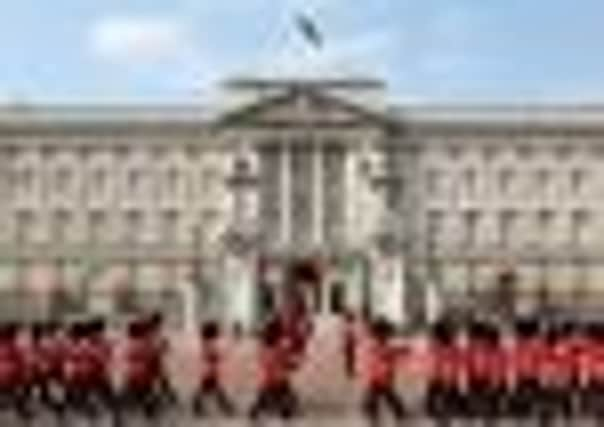Malcolm Barker: The Queen invites us all in to witness the change of the old guard at Buckingham Palace


They will be channelled through the State Rooms and see wonders in plenty, but the nearest they will get to Royalty is a sight of the Duchess of Cambridge’s wedding dress, and the portraits, which include delightful depictions of the young Victoria and Albert by Winterhalter.
This is appropriate because it was the young Victoria who was the first ruler to live at the palace after its early 19th century redevelopment, and her Consort, Prince Albert, who strove to make the huge and draughty building into a comfortable home.
Advertisement
Hide AdAdvertisement
Hide AdDespite his best efforts, and those of his successors, Buckingham Palace probably ranks only fourth in favourite dwelling places for the Royals, after Balmoral, Sandringham and Windsor Castle. It is a strangely unprepossessing building, and appears to have been designed to induce respect rather than affection.


Opening it to the public was not contemplated until the latter years of the reign of the present Queen, and it appears to have been a by-product of her annus horribilis, for it was the cost of making good the catastrophic damage to Windsor Castle in October 1992 that prompted the decision to let the public in for a couple of months a year (July 23 to October 3 this year). A nice little earner it has proved, too, with foreign visitors as well as Britons eager for admission.
Understanding a need for money would have been forthcoming from George III, who reigned from 1760 to 1820, and kept a canny eye on the purse strings, and his son, the gifted, artistic and profligate George IV (1820-1830), although the notion of admitting common folk and charging them for the privilege would surely have been beyond their comprehension.
The palace began as a townhouse for the Duke of Buckingham, and was acquired by George III in 1761. He and Queen Charlotte moved in, making a few alterations, but continued to use St James’s Palace for ceremonial occasions. On his accession, George IV engaged the architect John Nash to convert the townhouse into a palace. He was also spending large sums on Brighton Pavilion, and the money soon ran out.
Advertisement
Hide AdAdvertisement
Hide AdNash’s work was unpopular as well as expensive, and he was sacked on the death of his Royal master. King William IV (who reigned from 1830-1837) tried to rid himself of the house by offering it to Parliament, but this was refused, and work under the direction of the architect Edward Blore was not completed until May 1837, only a month before the King’s death. Thus, when Queen Victoria began her long reign (1837-1901), she was the first to use the palace not only as a home but also as an official residence. It does not seem to have offered much comfort. Fires emitted smoke into the rooms so volubly that, during the Queen’s first chill winter, they had to be allowed to die down even in the bitterest weather.
The court, we are told, “shivered in icy magnificence”, but the Queen was not worried, apparently being impervious to cold. Moreover, the drains did not work properly, ventilation was unsatisfactory so there were nasty smells, and security was absurdly lax. An intruder aged only 12 and known as “the boy Cotton” managed to live there without being caught for 12 months, hiding in chimneys, so he was covered from head to foot in soot, and blackened the beds he chose to sleep in.
Prince Albert was not content to let matters rest. Under his supervision the palace was rendered habitable, and became a smooth-running machine for the conduct of affairs of State. He was less concerned about the exterior, and the eastern façade, which faces down the Mall, was not remodelled until 1913, when the architect Sir Aston Webb made structural alterations. These included adding the balcony on which the Royals now congregate to present themselves to the multitudes, most recently at the wedding of Prince William and Kate.
It is one of the few working royal palaces remaining in the world today. Visitors are funnelled gently through 19 state rooms furnished with treasures from the Royal collection. The walls are hung with paintings by such masters as Poussin, Rembrandt and Rubens. The rooms themselves are magnificent examples of the work of John Nash at his most extravagant, and include echoes of his embellishment of Brighton Pavilion for George IV.
Advertisement
Hide AdAdvertisement
Hide AdOn my visit some years ago, I was eagerly studying the carpets wondering which lavish pile figured in a famous story about a great friend and colleague, John Edwards, editor of the Yorkshire Post. In conversation with the Queen at a Palace reception, he inadvertently trod on a corgi, which emitted a yelp. John feared the tower or worse, but the Queen was equal to the occasion. “They do rather blend with the carpet,” she remarked.
In opening part of the palace to the public, the Royals were following a long-established tradition. Black’s Picturesque Guide to Yorkshire (1867) contains a reference to Castle Howard, then “the magnificent seat of the Earl of Carlisle”. The guide extols the “liberality” of the Earl in allowing “its grounds and its treasures of art to be inspected daily by visitors”. No doubt similar gratitude to the Queen will be engendered among the loyal subjects treading through the magnificence of Buckingham Palace this summer, and there will be no need for them to beware of the dogs.
Malcolm Barker is a former editor of the Yorkshire Evening Post.